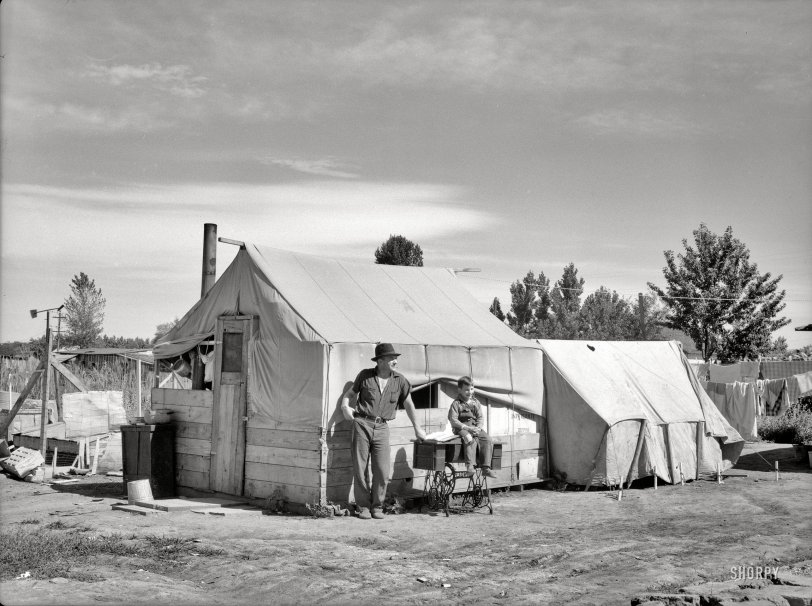


Framed or unframed, desk size to sofa size, printed by us in Arizona and Alabama since 2007. Explore now.
Shorpy is funded by you. Patreon contributors get an ad-free experience.
Learn more.

- Baldwin 62303
- Baldwin VO-1000
- Cold
- No expense spared
- Tough Guys
- Lost in Toyland
- And without gloves
- If I were a blindfolded time traveler
- Smoke Consumer Also Cooks
- Oh that stove!
- Possibly still there?
- What?!?
- $100 Reward
- Freeze Frame
- Texas Flyer wanted
- Just a Year Too Soon
- WWII -- Replacing men with women at the railroad crossing.
- Yes, Icing
- You kids drive me nuts!
- NOT An Easy Job
- I wonder
- Just add window boxes
- Icing Platform?
- Indiana Harbor Belt abides
- Freezing haze
- Corrections (for those who care)
- C&NW at Nelson
- Fallen Flags
- A dangerous job made worse
- Water Stop
Print Emporium
Our New Life: 1936

July 1936. "Migratory workers' camp in Yakima, Washington." Displaced farm families from the Dust Bowl states working as laborers in the Northwest's fruit orchards, living in government-run tent camps. Medium-format nitrate negative by Arthur Rothstein for the Resettlement Administration. View full size.
Fedoras
Some wear them well, others not so well. This man had looking debonair nailed even in a numbingly humble situation.
Props
That weather vane is just for showing the direction of the wind—this one has a propeller on the front that would spin in the breeze. I have a Singer pedestal sewing machine just like that one in my small collection, and I once helped build a tent house virtually identical to that one for a museum display. It was surprisingly comfortable, but then, I didn't have to live in it.
Thankful
Photos like these remind me to be thankful that my parents, who were born the very end of the 1920s, were both from Washington. My father's hometown is Ellensburg, which is very close to Yakima, and my mother was from Walla Walla, down near the Oregon state line. Their families weren't totally unaffected by the depression, but the land didn't turn against them, like it did in much of the country. My mother's people were farmers. Although she and her parents had to live with Grandpa's parents until 1934, and things like new clothing were rare, they always had plenty to eat. I wonder how many of the people in these pictures stayed in the northwest, and how many eventually returned to their previous homes, once things there had improved.
Dbell, that area is well known for wind! When my father was in college, it was customary for the young men to use egg white, like a precursor to hair gel!
The House That Kent Built
It's interesting to note that the wood used to make part of the tent wall (to the right of the boy sitting on the sewing machine table) is from the shipping crate of an Atwater Kent console radio. Note, too, that 1936 was the year Kent closed the doors of his Philadelphia factory and moved to California.
Five will get you ten, the radio isn't inside the tent.
You don't need a weatherman . . .
Is that a wind vane in the left background? If it used to be a windmill, there sure isn't much left!
Keep Calm and Carry On
My heart goes out to these folks. Uprooting your lives and moving no telling where just to make it. I wonder how these people ended up, better or worse off. Looks like Dad and son are waiting for Mom to come in from the orchards, maybe for some mending to be done with that old treadle machine. Dads shirt sleeve and sons knee britches. I would love to have a treadle. No electricity needed!
























On Shorpy:
Today’s Top 5